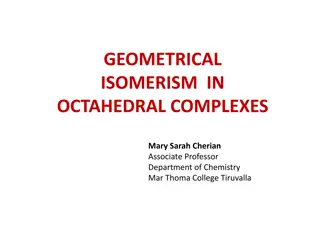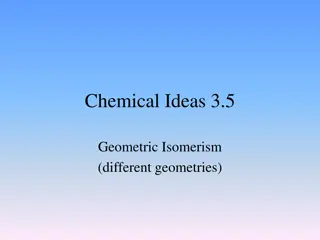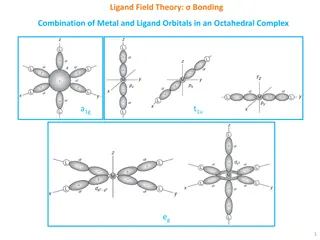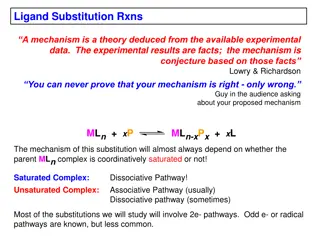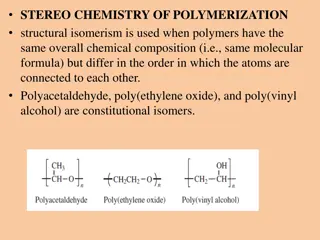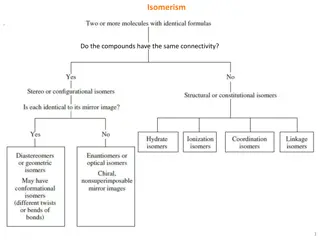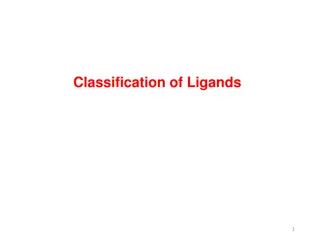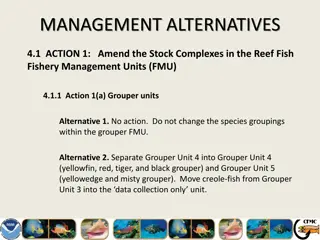Isomerism in Inorganic Complexes: A Comprehensive Overview
Isomerism in inorganic complexes is a fascinating phenomenon arising from the specific spatial arrangements of atoms within molecules. This article delves into the types of isomerism found in coordination compounds, such as structural isomerism and stereoisomerism. The importance of studying isomers for establishing the stereochemistry of complexes is highlighted, along with examples of ionization isomerism, hydrate isomerism, and ligand isomerism. Through this exploration, the complexity and significance of isomerism in coordination chemistry are elucidated.
Download Presentation

Please find below an Image/Link to download the presentation.
The content on the website is provided AS IS for your information and personal use only. It may not be sold, licensed, or shared on other websites without obtaining consent from the author. Download presentation by click this link. If you encounter any issues during the download, it is possible that the publisher has removed the file from their server.
E N D
Presentation Transcript
UNIT VA ISOMERISM AMONGS INORGANIC COMPLEXES Two or more different compounds having the same molecular formula are called isomers and the phenomenon is called isomerism. Isomerism arises due to specific spatial dispositions of the atoms in a molecule. Due to covalence of M-L bonds, many types of isomers occur in co-ordination compounds. However, compared to organic compounds, relatively few inorganic compounds exhibit isomerism.
Importance of isomerism in coordination chemistry Apart from complicating the study of co-ordination compounds due to a large variety of isomerism possible in complexes, the study of isomers played a very vital role in establishing the stereochemistry of complexes. Long before the advantage of physical methods of structure determination, like X-ray diffraction, such studies had established the stereochemistry of 6- and 4- co-ordinate complexes.
TYPES OF ISOMERISM Structural isomerism 1. Ionization isomerism 2. Hydrate isomerism 3. Ligand isomerism 4. Linkage (salt) isomerism 5. Co-ordination position isomerism 6. Co-ordination isomerism Stereoisomerism 1. Geometrical isomerism (cis-trans isomerism) 2. Optical isomerism (mirror image isomerism)
Ionization isomerism Ionisation isomers are the compounds that have the same molecular formula but give different ions in the solution. This occurs due to interchange of the ligand anion of the central metal atom and the external anion associated with the complex. e.g. [Co(NH3)5Br]+2SO4-2 & [Co(NH3)5 SO4]+1Br-1 [Co(NH3)5Br]+2SO4-2 gives white ppts of BaSO4 with aq BaCl2 while Co(NH3)5 SO4]+1Br -1 does not. Similarly Co(NH3)5 SO4]+1Br -1 gives yellow ppts of AgBr with aq. silver nitrate, while [Co(NH3)5Br]+2SO4-2 does not. Other examples are [Pt(NH3)4Cl2]Br2 and [Pt(NH3)4 Br2]Cl2, [Co(en)2NO2Cl]SCN & [Co(en)2NO2SCN]Cl
Hydrate isomerism: This isomerism arises due to different positions of water molecules in the complex (interchange between complex and rest of the compound). e.g. CrCl3 6H2O that is found in 3-isomeric forms. [Cr(H2O)6]Cl3: Violet, 4 ions, Equi.cond ~425, All chlorine ppted as AgCl, No loss of water in a desicator over conc. sulfuric acid. [Cr(H2O)5Cl]Cl2 H2O: Blue green, 3 ions, ~250, 2/3 chlorine ppted, One lost over conc sulfuric acid. [Cr(H2O)4Cl2]Cl2H2O: Darkgreen, 2 ions, ~130, 1/3 chlorine ppted, Two H2O lost over conc sulfuric acid.
Ligand isomerism Some of the ligands themselves are capable of existing as isomers, e.g. diaminopropane can exist isomers as 1, 2-diaminopropane (pn) and 1, 3-diaminopropane (tn).
e.g. [Co(pn)2Cl2]+ and [Co(tn)2Cl2]+ ions + + CH3 CH2 CH CH NH2 NH2 H2C H2C NH2 NH2 NH2 NH2 CH2 CH2 Co Co CH Cl Cl NH2 CH NH2 CH2 CH3 Cl Cl
Linkage isomerism This arises when the ligand can co-ordinate either of two different donor atoms (ambidentate ligands), e.g. NO2- ion may attach with the central ion either through O atm or through N atom. i.e. [Co(NH3)5-ONO]+2 & [Co(NH3)5- NO2]+2. Other ligands are SCN-, S2O3-2 etc.
Coordination isomerism This can occur only with salts in which both cation and anion parts are complexes and the ligands have a different distribution between the two central metal atoms (i.e. exchange of ligands between two coordination spheres). e.g. [Cr(NH3)6]+3[Cr(SCN)6]-3 & [Cr(NH3)4(SCN)2]+[Cr(NH3)2(SCN)4]- (same central atom) [Co(NH3)6]+3[Cr(CN)6]-3 & [Cr(NH3)6]+3[Co(CN)6]-3 (different central atom)
Coordination position isomerism In some of the polynuclear complexes, interchange of the ligands between the two metal nuclei takes place, which is give to rice to coordination position isomerism. e.g. + 2+ 2+ NH2 NH2 Cl(NH3)3Co Co(NH3)3Cl (NH3)4Co Co(NH3)2Cl2 O2 O2 symetrical unsymetrical
STEREOISOMERISM or SPACE ISOMERISM When two compounds have same ligands but its arrangement in space is different is known as space isomerism. There are two forms of stereoisomerism. 1.Geometrical Isomerism (cis-trans) 2.Optical Isomerism (mirror image)
GEOMETRICAL ISOMERISM or CIS-TRANS ISOMERISM 4-Coordinate complexes The arrangement of four ligands around the central metal atom may be tetrahedral or square planar. Tetrahedral complexes A regular tetrahedral species [Ma4],[Ma2b2]or [Mabcd] can exist in only one geometrical form (no geometrical isomers) since arrangement of every ligand atom or group around the central atom in space is equivalent.
Square planar complexes A planar species [Ma2b2] can exist in 1,2 or cis and 1,3 or trans form. No stereoisomer are possible for planar species of the type [Ma4], [Ma3b] or [Mab3] because arrangements of a and b for each of these types all possible are exactly equivalent.
Following types of complexes are show geometrical isomers 1. Complexes containing only monodentate ligand [Ma2b2] n [Ma2bc] n [Mabcd] n 2. Square planar complexes containing unsymmetrical bidentate chelating ligands [M(AB)2] n 3. Square planar complexes containing symmetrical bidentate chelating ligands [M(AA)2] n 4. Bridged binuclear planar complexes M2a2b4
[Ma2b2]n type: Here M is central ion and a and b are monodentate ligands. Complexes of this type exist following cis-trans isomers. e.g.[Pt(NH3)2Cl2] NH3 NH3 Cl Cl Pt Pt Cl NH3 Cl NH3 trans-isomer cis-isomer [Pd(NH3)2(NO3)2] also show cis-trans isomer.
[Ma2bc] n type: In this type a is any neutral ligand such as NH3, py, H2O and b and c are anionic ligands like Cl-, Br-,NO2- etc. e.g. [Pt(NH3)2ClNO2] NH3 NH3 Cl Cl Pt Pt O2N NH3 NH3 NO2 trans-isomer cis-isomer
M[abcd] n type Complexes of this type exist in three isomeric forms as shown below n+ n+ n+ n+ a a a c a c b b Pt Pt Pt Pt d d b c c d d b (III) (II) (IV) (I) examples are [Pt(NH3)ClBrNO2], [Pt(NH3)2pyClBr], [Pt(NO2)py(NH3)(NH2OH)]+, [Pt(C2H4)(NH3)ClBr]
Square planar complexes containing unsymmetrical bidentate chelating ligands: [M(AB)2] n AB is unsymmetrical bidentate chelating ligands containing A and B are two end of the ligand. e.g. [Pt(gly)2] where gly is NH2-CH2COO- (glycine ion), exist following cis-trans isomers 0 0 CH2 H2C NH2 H2C O CO NH2 NH2 Pt Pt O CO CH2 NH2 OC OC O O trans-isomer cis-isomer
Square planar complexes containing symmetrical bidentate chelating ligands:[M(AA)2] n where AA is symmetrical bidentate chelating ligands . e.g. [Pt(NH2CH(CH3)CH(CH3)NH2)2]+2 2+ 2+ CH3 CH3 H H3C C C NH2 C C NH2 NH2 NH2 H CH3 H3C H H CH3 Pt Pt H H3C C NH2 C NH2 C NH2 C NH2 H3C H H H trans-isomer cis-isomer
Bridged binuclear planar complexes of M2a2b4 type In this type of complexes cis and trans isomers as well as the unsymmetrical form also exist as shown below. e.g. [Pt(PEt3)Cl2]2 Et3P Cl Cl Cl Cl Et3P Cl Cl Cl Pt Pt Pt Pt Pt Pt PEt3 Cl PEt3 Cl Cl Cl PEt3 Cl Et3P trans-form cis-form unsymmetrical-form
6-Coordinate complexes Three possible arrangements of six ligands around the central metal atom, namely Planar hexagonal Trigonal prismatic Octahedral The physical and chemical evidences, especially those based on isomerism have shown that the arrangement of six ligands in a 6-coordinate complex is always octahedral with all six positions equivalent.
Octahedral complexes The arrangement of six ligand in a regular octahedral complex round the central metal ion can be represented as shown below: 1 2 5 Pt 3 4 6
Octahedral Complexes containing monodentate ligands 1. [Ma4b2] n type 2. [Ma3b3] n type 3. [Mabcdef] n type Octahedral Complexes containing monodentate and symmetrical bidentate ligand 1. [M(AA)2a2] n type 2. [M(AA)2ab] n type 3. [M(AA)a2b2] n type Octahedral Complexes containing unsymmetrical bidentate chelating ligands [M(AB)3] n type
Octahedral Complexes containing monodentate ligands In this complexes, [Ma6] n, [Ma5b] n and [Mab5] n types are not show geometrical isomerism. Following types are show isomerism 1. [Ma4b2] n type 2. [Ma3b3] n type: 3. [Mabcdef] n type
[Ma4b2]n type Two b ligands have adjacent position for cis isomers, while in trans form two b ligands are diagonally opposite to each other It means in cis form b ligands lie on any of the twelve edges of the octahedron and in trans form b ligands are at end of the straight line passes through the central atom
Example: [Co(NH3)4Cl2]+ In cis isomers, two Cl ions are at the adjacent position (i.e. 1,2-position), while ln trans isomers two Cl- ions are opposite to each other (i.e. 1,6-position).
[Ma3b3]n type In cis isomers, three a occupy 1, 2 and 3 positions and in trans isomers 1, 2 and 6 positions.
Example: [Cr(NH3)3Cl3], [Rh(py)3Cl3] In cis isomer, three Cl- ions are on the triangular face of the octahedron and three NH3 molecules are on the opposite triangular face of the octahedron hence is called facial isomer. In trans isomer, three Cl- ions are around the edge of the octahedron and three NH3 molecules are at the opposite edge of the octahedron, hence is called peripheral isomer.
[Mabcdef]n type In this type of complexes there are 15 different geometrical isomers in which all have optical isomers. Only one compound known is [Pt(py)(NH3)(NO2)ClBrI]. In this compound only three forms are obtained but no attempt has been made to isolate all the 15 isomers.
Octahedral Complexes containing monodentate and symmetrical bidentate ligands [M(AA)2a2] n type In cis isomer, a are cis to each other and in trans isomers a are trans to each other.
Example: [Co(en)2(NO2)2]+, [Ir(C2O4)2Cl2]2-, [Rr(C2O4)2Cl2]2-, [Co(en)2Cl2]+, [Cr(C2O4)2 (H2O)2]- etc. In cis isomer two Cl- ions are cis to each other and trans isomers two Cl- ions are trans to each other.
[M(AA)2ab]n type Example: [Co(en)2(NH3)Cl]2+, [Ru(py)(C2O4)2 (NO)] etc.
[M(AA)a2b2]n type Example: [Co(en)(NH3)2Cl2]2+
Octahedral Complexes containing unsymmetrical bidentate chelating ligands:[M(AB)3] n type Example: [Cr(gly)3]
VARIOUS METHODS TO DISTINGUISH BETWEEN CIS AND TRANS ISOMERS 1. Dipole moment 2. X ray crystal analysis 3. IR technique 4. Grinberg s method 5. Kurnakov s method
Dipole moment Jensen has shown that the Pt(II) complexes of [PtA2X2] type(where A = substituted phosphine, arsine and X = halogen) have their dipole moment equal to zero or between 8 & 12 debye unit. If dipole moment is equal to zero then individual moments have cancelled one another, so these are trans isomer. If 0 (i.e. 8-12) are cis isomer.
X ray crystal analysis X-ray crystal analysis of several Pt(II) complexes have confirmed the square planarity of the bond around the central metal. This arrangement has also been established for 4- coordinated complexes of Pt(II), Ag(II), Cu(II) and Au(II).
IR technique complexes The trans such [Co(NH3)4Cl2]+ symmetrical as or [Co(NH3)2Cl2]+, vibration produce no change in the dipole moment of the the Cl-M-Cl stretching molecule. Hence no band corresponding to this vibration is observed in IR spectra.
However, in the cis form, the symmetrical as well as unsymmetrical stretching vibration produce change in the dipole moment, hence in cis isomer will show large number of bands due to Cl-M-Cl stretching.
Grinbergs method It is chemical method in which a chelating ligand having two donor atoms react with cis and trans isomers. In cis isomer, two donor atoms of chelating ligand coordinate to the central atom at two cis positions and form five or six membered ring, while in trans form, chelating ligand coordinate to the central atom by any one of the donor atoms and acts as a monodentate ligand i.e not form a ring complexes with trans form. The chelating ligand used are oxalic acid (COOH)2, glycine (H2N-CH2- COOH) and ethylenediamine (H2N-CH2-CH2-NH2). Oxalic acid and glycine ligands example are given below with [Pt(NH3)2Cl2]
0 C NH3 O O (COOH)2 + + 2HCl Pt+2 0 C O O NH3 NH3 Cl Chelated complexes Pt+2 Cl NH3 0 cis-form C NH3 O O + H2NCH2COOH + HCl Cl Pt+2 CH2 NH2 NH3 Chelated complexes
0 NH3 OOC-COOH (COOH)2 +2 + 2HCl Pt+2 NH3 HOOC-COO 0 NH3 Cl Non-chelated complexes Pt+2 NH3 Cl 0 trans-form NH3 NH2CH2COOH H2NCH2COOH +2 Cl2 Pt+2 NH3 HOOCH2CH2N Non-chelated complexes
Kurnakovs method Kurnakov utilised the phenomena of trans effect in distinguishing the cis and trans isomers of square planar complexes of [PtA2X2] type by treating them with thiourea. i.e. (tu) -2 - 0 X A A +A -X- +A -X- X Pt+2 X X Pt+2 X A Pt+2 X X X X cis-[PtA2X2] +2 + 0 A A A +X- +X- A Pt+2 A A Pt+2 X X Pt+2 X -A -A A A A trans-[PtA2X2]
e.g. [Pt(NH3)2Cl2] In cis isomer both Cl- ion are trans to NH3 ligands, so because of trans effect Cl- ions are replaced by tu (Thiourea) and from [Pt(NH3)2(tu)2]+2 (i.e. I) Now in [I] bothNH3 are trans to tu, hence tu is replaced by tu and from [Pt(tu)4]+2.
In case of trans isomer, trans effect is smaller, so we get [Pt(NH3)2tu2]+2.
OPTICAL ISOMERISM OR MIRROR IMAGE ISOMERISM When the solutions of complexes are place in the path of plane polarized light, than light rotates its plane through certain angle either to the left side or right side. This property of complex of rotating plane of polarized light is called its optical activity and the complexes possessing this property is said to be optically active.
Optically active complexes are said to exist in the following forms: a) Which rotates plane of polarized light towards right side (clockwise direction) is said to be dextro-rotetory or d- form. It is also represented by (+) sign. b) Which rotates plane of polarized light towards left side (anticlockwise direction) is said to be laevo-rotatory or l- form. It is also represented by (-) sign. (+) and (-) refer to sign of rotation of optical isomer. c) Which is not capable of rotating the plane polarized light is called optically inactive. This isomer is call recemic-[dl, or ( )] from which is made up of 50% d & 50% l- form. In recemic form, one form rotates the plane of polarized light in one direction is balanced by other form in opposite direction.
The d- and l-form have following characteristics i. Since d and l form are capable of rotating the plane of polarized light, are said to be optically active or optical isomer. This phenomenon is called optical isomerism or optical activity. Both isomers have exactly identical physical and chemical properties. ii. If d and l form are mirror image to each other and not superimposed on each other, they are called enantiomerism.
Condition for a molecule to show optical isomerism 1. The molecule should be asymmetric which never has a plane of symmetry. It means the molecule divides by an imaginary plane in such a way that part of one side of plane is the mirror image of the other side of plane. Which is called plane of symmetry and it is always inactive while molecule have not plane of symmetry are optically active and hence show optical isomerism. 2. An asymmetric molecule cannot be superimposed on its mirror image.
Optical isomerism in 4-coordinate complexes: Mirror image isomerism is not possible tetrahedral and square planar complexes of type [Ma4], [Ma3b] and [Mab3].


